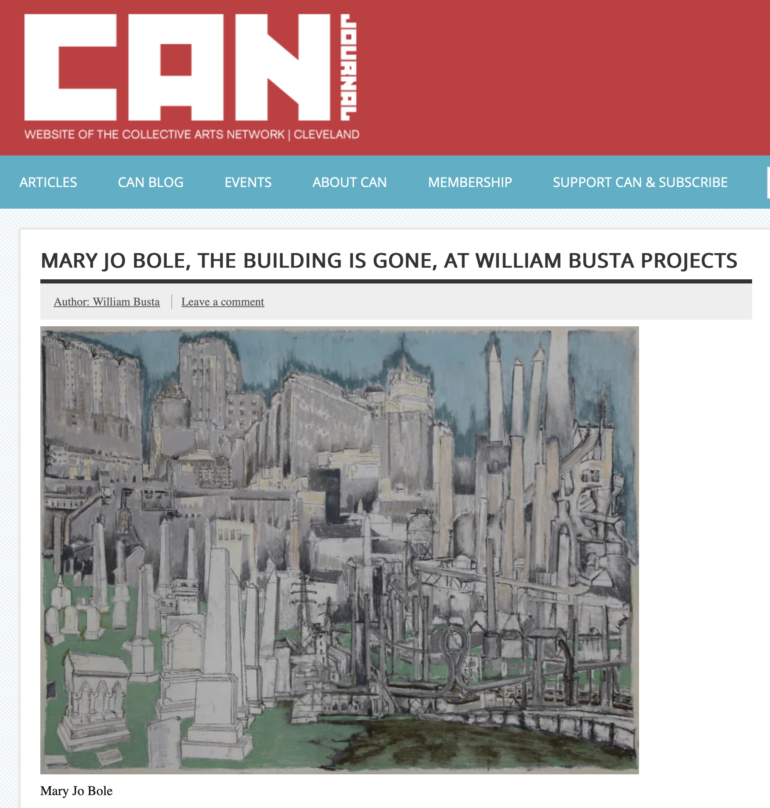
Exhibition Review in CAN Journal
April 23, 2023
Exhibition Review in CAN Journal, Summer 2022, page 22:
MARY JO BOLE, THE BUILDING IS GONE, AT WILLIAM BUSTA PROJECTS
There is something about how we remember things, and then there is something about how we wish to remember things, and then there is something about how we wish things that we remember were different. These are some of the lenses of history.
Mary Jo Bole draws upon her experiences, wide-ranging around Cleveland since childhood, while just a little drunk with an elixir of family history that blends vintages, mellowed and invigorated, generation to generation. Both energetic and contemplative, her work invites us to a personal vision of the city’s heart and soul.
In a sense, all geography is perceptual and personal. We all arrange by what we know and what is meaningful. These works are how the artist perceives. There is an intimacy in cemeteries, which for many people are places of mourning, often near holidays or anniversaries of births, marriages, and deaths. But for a child they can be a playground, and for the reflective they can be a connection that unites past with present. Today, the era of steel mills and smokestacks feels far away and seemingly romantic and heroic. But steel is made here daily and the ships still enter the Cuyahoga River loaded with ore from the iron ranges. No, not what it once was, but vibrant recollection as to how we became who we are. And above our eyes are monumental structures of brick and stone and steel and glass that enclose our public square, drawing attention in self-importance, towering above.
Perhaps playfully, in one work Mary Jo Bole juxtaposes office towers with obelisks that rise above factory and river. It is an Easter egg for historians, in-the-know about the obelisk that towers above the graves of Rockefellers in Lake View Cemetery, and of how the Rockefeller oil refineries began the transformation of Cleveland from a mercantile to an industrial center.
Real drawing happens when intelligence moves the hand, without attention to the mechanics of wrist or elbow or shoulder. In color of the city—oranges and yellows and browns and greys, the artist sketches in repetition. Structure becomes pattern. Pattern becomes composition. And we enter her world, if only for a momentary glimpse.
In part, this series of images recollects an iconic photograph by Walker Evans (1903-1975)—Graveyard, Houses, and SteelMill—created as part of a government project during the Great Depression. Sponsored by the Farm Security Administration, photographers were sent throughout the United States to document rural life. Walker Evans expanded upon the instruction of the program’s shooting scripts, pursuing his own vision. In 1935 he chose to photograph the steel towns of the Lehigh Valley of Pennsylvania. Since the photographs were created with public funds, copies were available on request. In requesting this image, one woman explained with some passion, “I want to give it to my brother who’s a steel executive. I want to write on it ‘Your cemeteries, your streets, your buildings, your steel mills. But our souls, God damn you.’”
There is all of that in Mary Jo Bole’s work. But there is also sentimentality, in the best possible sense of the word. It’s affection and some joy and some memory of a lifetime curating and celebrating a city that will always be home.
MARY JO BOLE: THE BUILDING IS GONE | MAY 6–JUNE 4
CAN TRIENNIAL INSTALLATION | JULY 9–AUGUST 31
William Busta Projects
15517 Waterloo Road
Cleveland, Ohio 44110
[email protected]
216.401.2752
Open Wednesday through Saturday from noon to 5 pm during scheduled exhibitions.
© 2024 Mary Jo Bole
